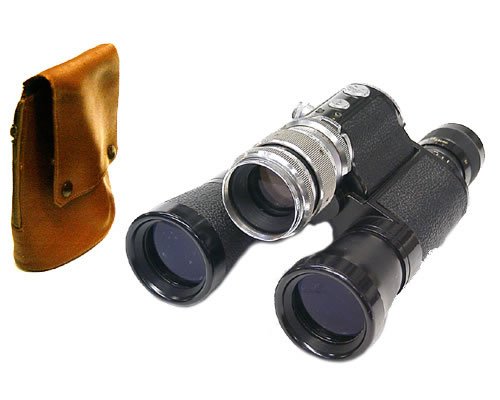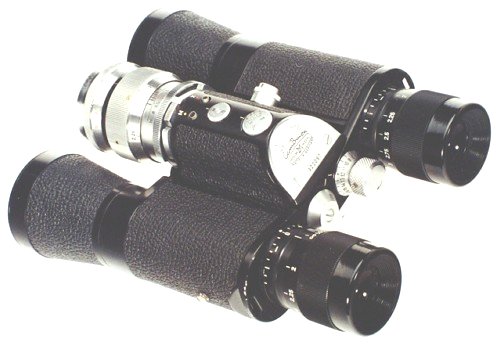
Introduction | 90mm | 35mm | 135mm | film
Following in the footsteps of the Toko Cyclops and Teleca the microscope maker J.D. Mőller Optical Works of Wedel, West Germany introduced the CamBinox in 1956 combining a 7x35 binocular with a 16mm subminiature camera. The special double film cassette holds 20 exposures of 10x14mm. The cassette is made of plastic and are reloadable.
There is a reverse roof-prism in the camera so that the film and shutter are horizontal, and the image brought in and down to the film, which was loaded from underneath.

Focusing the binoculars and transferring the reading to the f3.5/90mm lens centres between the two oculars gives surprisingly good results. Each eye piece can be focused independently and have dioptre adjustment for short and long sightedness.
The camera lens is interchangeable with 35mm, 135mm and 180mm lens. The 90mm lens has the same aspect ratio as the binoculars (127/100 metres). The 35mm has a wider field of view, such that the tips of the binoculars get included in the photographs, and the 135mm narrowed the image to the central portions of the image seen through the oculars. All lenses had f-stops from f3.5 through f16 and focused to 2 metres (6.5 feet). The standard lens is a six element Jdemar f3.5, 90mm highly corrected and of exceptional sharpness. A prototype 180mm lens was also made.
The 135mm lens also required the use of a special eyepiece reticule. There are two models of the CamBinox, the Model N which required the extra reticule and the Model S which had it built in as a secondary set of field lines.
The 35mm lens is chrome, the 90mm in chrome or black and the 135mm and 180mm in black.
The metal focal plane has shutter control, ranging from 1/30th to 1/800 is adjusted by a dial near the film counter are at the back of the camera between the eye pieces.
The camera also has a synchronised flash socket for M and X and has a accessory clip for rangefinder, flash attachment, view finder and exposure meter.
The tripod bush is in the body of the camera.
The 90mm lens has an outside diameter of 37mm and inside diameter for screw thread adapter of 35mm.
A single action of film winding knob advances the film, cocks the shutter and registers the number of the picture. The oversized release button allows exposures even when gloves are worn. A cable release can also be inserted into the centre thread of the release button.
Although looking ungainly the whole unit has a nice balance.
Accessories included an enlarger, projector and developing tank.
Promotional: Moller, The Photo-Binocular CamBinox, nd 16pp, fully illus.; approx. 7x4". Very scarce booklet showing features and capabilities of this 16mm binocular camera. EX. $50.00
Moeller: 1950s Taschen-Prismen-Glaeser (2p); 1950s Cambinox (2p); 1950s Cambinox (2p); 1950s Marex - Marox (2p); 1951 Program of Production (8p); 1951 galileans (2p); n.d. Kleinoptik (8p).

More photographs of the Cambinox at Benbojo Classic Camera's http://home.tiscali.nl/benbojo/cambinox_bin.htm